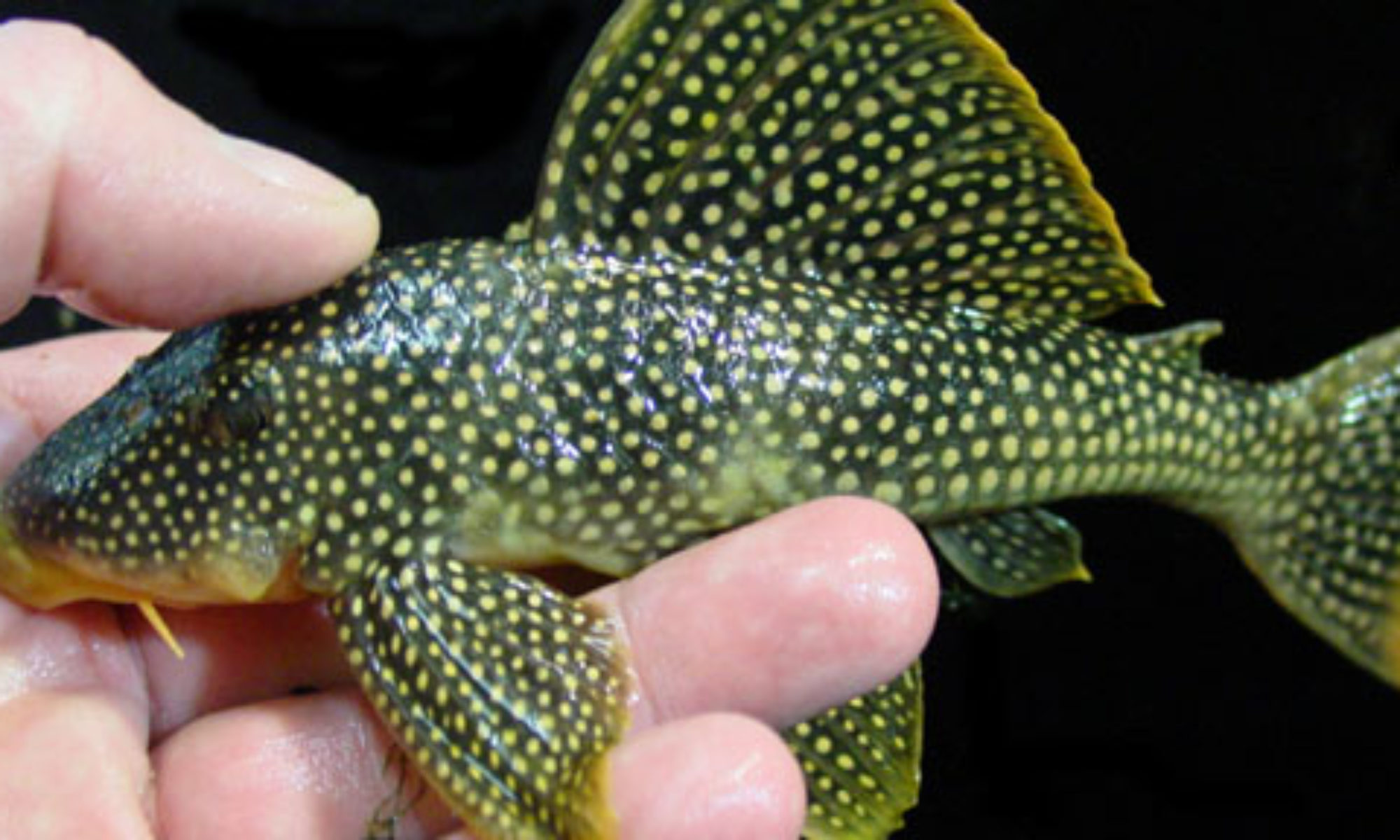Common Bristle Nose Catfish (Ancistrus sp.) in NZ
BRISTLE NOSE CATFISH, BUSHY NOSE CATFISH, ANCISTRUS CATFISH, BN CATFISH
All are terms for one of the most useful catfish to have in any aquarium Ancistrus cf_cirrhosus. They are armor plated, peaceful algae eaters that won’t harm other tank inhabitants be they plants or fish.
ANCISTRUS (ANN SIS TRUSS)
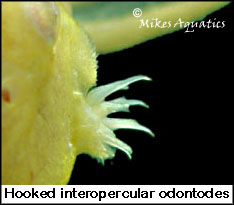 Ancistrus = Hooked and is a reference to the tiny hooked barbs on the cheeks of both sexes. (Interopercular Odontodes to use the correct term. Interopercular = Gill plates, Odontodes = Hairy or Spiny growths) These are extended when the fish is startled and help to keep it lodged in its protective cave, they also become very easily entangled in nets, you should avoid netting BN cats if at all possible. The easiest way to catch them is to drain the water from the tank then just carefully pick them up with a wet hand. If a BN does become entangled in a net don’t attempt to pull it out, the harder you pull the more the spikes will dig into the net, just place the net back into the water and when the BN calms down he will retract the hooks and usually untangle himself.
Ancistrus = Hooked and is a reference to the tiny hooked barbs on the cheeks of both sexes. (Interopercular Odontodes to use the correct term. Interopercular = Gill plates, Odontodes = Hairy or Spiny growths) These are extended when the fish is startled and help to keep it lodged in its protective cave, they also become very easily entangled in nets, you should avoid netting BN cats if at all possible. The easiest way to catch them is to drain the water from the tank then just carefully pick them up with a wet hand. If a BN does become entangled in a net don’t attempt to pull it out, the harder you pull the more the spikes will dig into the net, just place the net back into the water and when the BN calms down he will retract the hooks and usually untangle himself.
FEEDING
While they can get by on a diet of algae and scavenged food from other fish to do well they need an occasional ‘vege’ feed. Courgettes are readily eaten, as are shelled peas. most bottom feeder / pleco tablets are also eaten. Snap or cut the Courgette into lengths of about 2 inches, stab them with a teaspoon and drop into the tank, the BN’s will find the food in no time, and you may be surprised what other fish will also nibble away at the courgette. For more details check out my Foods and Feeding Page
HOUSING
BN plecs like to have a cave or hidey hole into which they can retreat or hide, if you want to try breeding them, then a cave is essential. Bog wood they can hide under will do fine, or a bamboo or slate / tile cave. They are tolerant of most water conditions and can be put into practically any tank. They don’t eat plants although they will occasionally leave small rasping patches on broad leaves (a sign they need some more ‘vege feed’).
SEXING
Sexing BN Cats is very easy; the males sport the fleshy bristles the females don’t. Scientific theory is that the bristles are supposed to look like baby BN that the male is guarding, thereby assuring any passing females of his ability to defend a brood of young and of his suitability as a mate. Any BN Cat of around 2 inches or more with no or very underdeveloped bristles is a female.
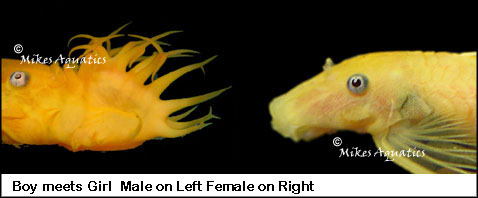 VARIANTS
VARIANTS
Whilst there are several hundred species of ancistrus some identified some not the one most likely to be encountered by the aquarist in New Zealand are the various color forms of Ancistrus cf_cirrhosus. Variants include Normal or Common (Brown / Grey in color), the Golden Black Eye or GBA, the Golden Albino, The Piebald or Calico and the Red Jewel.
COMMON BRISTLE NOSE
(Ancistrus SP3 / Ancistrus cf_cirrhosus)
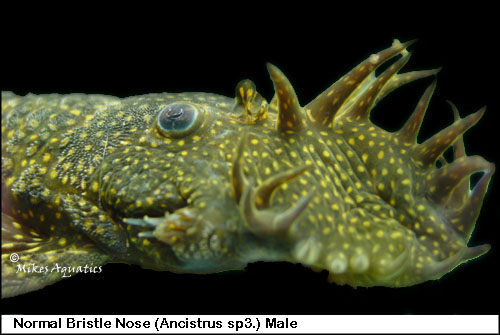
As the name suggests this is the most commonly encountered BN cat generally a dark olive grey to brown overall color with lighter spots covering the entire fish. Beauty is definitely in the eye of the beholder when it comes to these guys but they do an excellent job of keeping algae to a minimum in just about any tank. Just about any pet shop should have Common BN’s available.
GOLDEN BLACK EYED ANCISTRUS (GBA)
(Ancistrus SP4 / Ancistrus cf_cirrhosus)
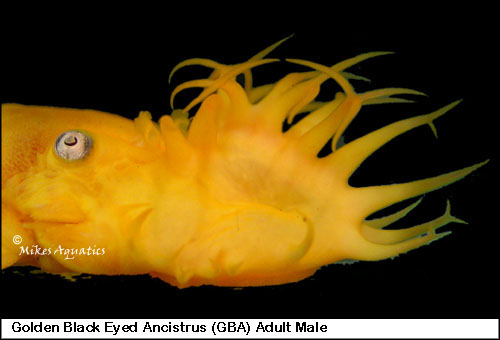 The Golden Black Eyed Ancistrus / Golden Blue Eyed / (GBA) is a result of a genetic defect known as Amelanism.
The Golden Black Eyed Ancistrus / Golden Blue Eyed / (GBA) is a result of a genetic defect known as Amelanism.
It is basically the same principal as an albino defect but is a lack of dark pigment, as opposed to a lack of all pigments, in albinism.
Albino – lacking all pigment
Melanistic – Excessive Dark pigments
Amelanistic – Lacking Dark Pigments
As it is a genetic defect it is passed from parent to offspring using the usual laws of genetics.The original amelanistic male Ancistrus was wild caught in Paraguay; he was bred with a normal female and then the resulting offspring were re-crossed until the defect became ‘fixed’ and all offspring produced from a pair had the defect. Being a recessive gene it can be present in a fish without the fish having any external appearance of having the gene. So it is possible for two seemingly ‘normal’ looking ancistrus to produce some GBA offspring if both parents are in fact GBA/Normal hybrids carrying the Amelanistic gene. GBA’s are a little rarer than common’s but are usually available from most pet shops. They are sometimes erroneously referred to as being L144 but as they aren’t generally wild caught specimens in NZ this is an incorrect label.
GOLDEN BRISTLE NOSE ANCISTRUS
(Ancistrus SP3 – Albino / Ancistrus cf_cirrhosus)
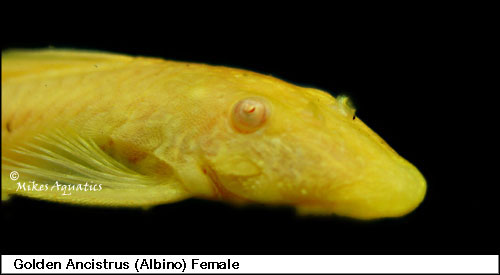 Golden Ancistrus are a result of a genetic defect known as albinism and are commonly known as albino ancistrus. The obvious difference between GBA and Golden is the pink eyes in the Golden and Black eyes in the GBA. Again as it is a recessive gene it is possible for two supposedly normal looking ancistrus to produce some albino offspring if they are both in fact normal/albino hybrids carrying the albino gene. Golden albinos are perhaps the rarest of the three variants covered here, and will cost you a little more, but they are a cool looking fish even if you don’t generally like Albino fish.
Golden Ancistrus are a result of a genetic defect known as albinism and are commonly known as albino ancistrus. The obvious difference between GBA and Golden is the pink eyes in the Golden and Black eyes in the GBA. Again as it is a recessive gene it is possible for two supposedly normal looking ancistrus to produce some albino offspring if they are both in fact normal/albino hybrids carrying the albino gene. Golden albinos are perhaps the rarest of the three variants covered here, and will cost you a little more, but they are a cool looking fish even if you don’t generally like Albino fish.
PIEBALD / CALICO
(Ancistrus SP3 – Piebald/ Ancistrus cf_cirrhosus)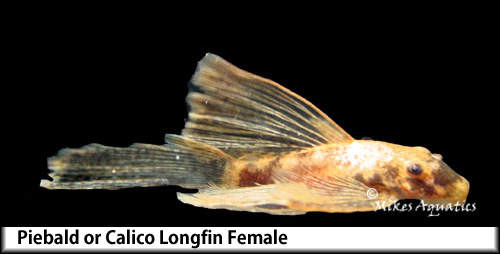
Piebald is a color sport where the fish comes out with a marbled gold and brown pattern, they are rarer than the usual colors but not too hard to find.
RED JEWEL
(Ancistrus SP3 / Ancistrus cf_cirrhosus)
Red Jewel is a similar color sport to Piebald but with a more intense gold almost red coloration, they are the rarest of the colors available in New Zealand.
VEILTAIL / LONGFIN BRISTLENOSE
(-/-)
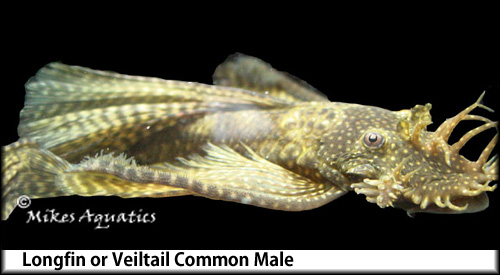
All the fish listed above are also available with a further mutation which gives them extra long extended fins (veiltails)
BREEDING IN NEW ZEALAND
All variations of the Common Bristlenose are well established and being bred in New Zealand by aquarists across the country. The only one that is hard to find is the Red Jewel. They are an easy fish to breed, all you need is a mature pair and a suitable cave.
